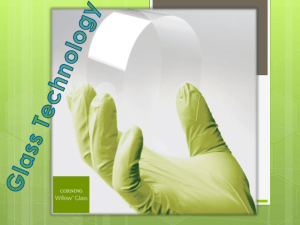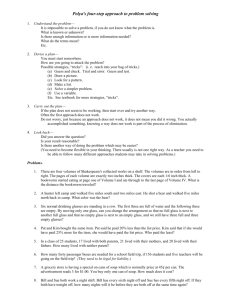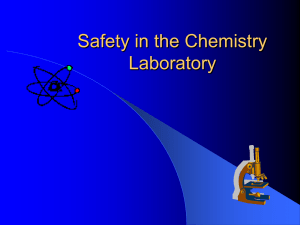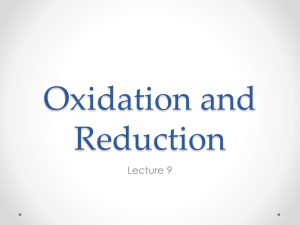Redox behavior of platinum-group metals in nuclear glass
advertisement
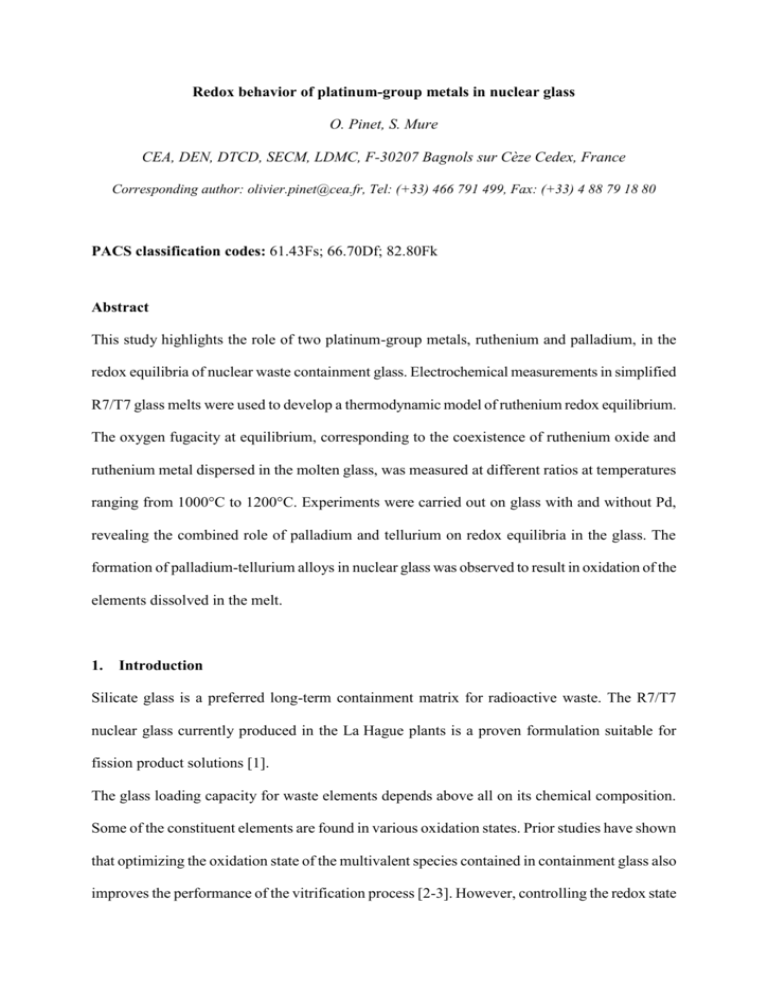
Redox behavior of platinum-group metals in nuclear glass O. Pinet, S. Mure CEA, DEN, DTCD, SECM, LDMC, F-30207 Bagnols sur Cèze Cedex, France Corresponding author: olivier.pinet@cea.fr, Tel: (+33) 466 791 499, Fax: (+33) 4 88 79 18 80 PACS classification codes: 61.43Fs; 66.70Df; 82.80Fk Abstract This study highlights the role of two platinum-group metals, ruthenium and palladium, in the redox equilibria of nuclear waste containment glass. Electrochemical measurements in simplified R7/T7 glass melts were used to develop a thermodynamic model of ruthenium redox equilibrium. The oxygen fugacity at equilibrium, corresponding to the coexistence of ruthenium oxide and ruthenium metal dispersed in the molten glass, was measured at different ratios at temperatures ranging from 1000°C to 1200°C. Experiments were carried out on glass with and without Pd, revealing the combined role of palladium and tellurium on redox equilibria in the glass. The formation of palladium-tellurium alloys in nuclear glass was observed to result in oxidation of the elements dissolved in the melt. 1. Introduction Silicate glass is a preferred long-term containment matrix for radioactive waste. The R7/T7 nuclear glass currently produced in the La Hague plants is a proven formulation suitable for fission product solutions [1]. The glass loading capacity for waste elements depends above all on its chemical composition. Some of the constituent elements are found in various oxidation states. Prior studies have shown that optimizing the oxidation state of the multivalent species contained in containment glass also improves the performance of the vitrification process [2-3]. However, controlling the redox state in containment glass requires a complete description of the redox equilibria involved [4]. Due to their abundance, cerium, iron and ruthenium have already been identified as multivalent elements with decisive impact on the redox equilibrium in the glass. Chromium, nickel and manganese also take part in redox reactions within the melt, but to a lesser extent because of their lower abundance in R7/T7 glass. This study focuses on platinum-group metals, whose redox behavior in the glass has not been widely investigated despite their appreciable role with regard to the overall redox state of nuclear glass. Because the platinum-group metals are very sparingly soluble, their redox behavior is potentially different from that of the multivalent species dissolved in the glass. Ruthenium was the primary subject of investigation; we also studied palladium because it can lead to the reduction of tellurium and form metal alloys. Electrochemical measurements in simplified R7/T7 glass melts were used to develop a thermodynamic model of ruthenium redox equilibrium. Experiments were carried out on glass with and without Pd to study the combined role of palladium and tellurium on redox equilibria in the glass. 2. Theoretical aspects of redox equilibria 2.1 General: multivalent species dissolved in the glass melt As with any solvent, the stabilization of a multivalent element at a given oxidation level in the glass depends on the thermodynamic conditions (temperature and pressure of the solvent/solute system), on the electronegativity of the ion species (its intrinsic tendency to attract electrons), on the solvent solvation properties, and on the possible presence of ligands in solution [5]. The parameters affecting the ratio between the concentrations of the reduced species and the oxidized species of a redox couple Mm+/M(m-n)+ can be identified by equalizing the potentials of the two redox equations for the M(m-n)+/Mm+ and O2/O2– couples: M(m-n)+ Mm+ + ne– (1) 2O2– O2 + 4e– (2) The redox potential corresponding to this equation is given by the Nernst equation: E EOM M m RT ln γM m RT ln nF M (m n) nF γM (m n) (3) where γ M (m n) and γ M m are respectively the activity coefficients of M (m-n)+ and Mm+ ions in the glass, EOM is the standard oxidation reduction potential of the couple M (m-n)+/Mm+, and the brackets indicate concentrations. At equilibrium in the glass, the potential is aligned with that of the O2/O2– couple. The redox potential of the O2/O2– couple is as follows: E RT fO2 ln nF aO 2 2 (4) where fO2 is the oxygen fugacity in the glass and a(O2–) is the activity of the O2– ions in the glass. The balance reaction is thus: n n M m O2 Mm n O2 2 4 The redox ratio (5) Red M(m n) Mm follows the relation: Ox log Red nF n n EOM log α log aO2- log f O 2 Ox 2.3 RT 2 4 (6) α γM (m n) γM m (7) where and EOM ΔG 0 ΔH 0 ΔS 0 T nF nF nF (8) G0, H0, S0 are respectively the standard free enthalpy, standard enthalpy and standard entropy of the redox equilibrium M(m-n)+/Mm+. Equation (6) can then be rewritten as follows: log Red ΔS 0 ΔH 0 n n log α log aO 2 - log f O 2 Ox 2.3 R 2.3 RT 2 4 (9) From equation (9), the major factors affecting the redox state are the following: • Temperature T. • Glass basicity a(O2–). • Melt composition. • Oxygen fugacity fO2. Increasing fO2 results in greater oxidation of the polyvalent elements in the glass. Equation (9) clearly shows a first-order linear relation with a slope of n/4 between log(fO2) and log([Red]/[Ox]); this relation was also observed experimentally with many glasses [6]. A simplified equation was proposed [5] with a characteristic oxygen fugacity term, fcharO2.: log Red n log fcharO 2 log f O 2 Ox 4 (10) From equations (6) and (10): log fchar O 2 4F 4 E0 M log α 2 log aO2 - 2.3 RT n (11) This quantity has a physical signification: it indicates the oxygen fugacity value beyond which the oxidized form of the redox couple predominates in the melt. If log fO2 > logfcharO2 then Red/Ox < 1 If log fO2 < log fcharO2 then Red/Ox > 1 The characteristic oxygen fugacity depends primarily on the redox couple considered, on the measured temperature and on the basicity of the glass in which the redox species is dissolved. 2.2 Ruthenium Ruthenium is a fission product found at concentrations exceeding 1 wt% in R7/T7-type containment glass. The redox behavior of ruthenium in the glass has not been widely investigated. Although ruthenium has been detected in glass at oxidation states +III, +VI and +VIII, it is generally observed at oxidation states +IV and 0. Under highly oxidizing conditions, ruthenium can also occur as a gas, RuO4. Ruthenium at redox states +III and +VI could also exist in soluble form in the glass but the measured ruthenium solubility does not exceed a few hundred ppm [7]. At oxidation states +IV and 0, ruthenium is insoluble or sparingly soluble and is consequently observed as grains or needles dispersed in the glass [8]. The equilibrium constants of the oxidation reaction RuO2 Ru + O2 are given in Table I for a mixture of pure metal and oxide. Two models were considered in this study for the relation between the Ru0/Ru4+ redox molar ratio and the oxygen fugacity in the glass melt. Model I is based on the following hypotheses: • The only redox states involved in oxidation-reduction reactions in the glass are +IV and 0. • The redox behavior of ruthenium is of the same nature as that of a redox species dissolved in molten oxide; the redox couple Ru0/Ru4+ is at equilibrium with the oxygen fugacity in oxide melts and the general equation (10) is therefore applicable. Model II postulates the following hypotheses: • The only redox states involved in oxidation-reduction reactions in the glass are +IV and 0. • The redox behavior of ruthenium is equivalent to that of a powder mixture of ruthenium metal and ruthenium (+IV) oxide at equilibrium with the oxygen gas physically dissolved in the glass: at a given temperature there is a characteristic oxygen fugacity value below which all the ruthenium is at oxidation state 0 in the form of ruthenium metal and above which all the ruthenium is at state +IV in the form of RuO2. When the oxygen fugacity is equal to the characteristic oxygen fugacity, the oxidized and reduced forms of ruthenium coexist. Figure 1 shows the Ru0/Ru(total) redox molar ratio versus the oxygen fugacity according to the two models mentioned above. Ru(total) is the molar sum of Ru4+ and Ru0 in the glass. The purpose of the electrochemical studies was to determine the fcharO2 values for the couple Ru4+/Ru0, and to assess the suitability of the two models. To identify the thermodynamic relations between the ruthenium redox state and the oxygen fugacity versus the temperature, simplified glass samples were prepared with different Ru4+/Ru0 redox ratios. The fugacity, fO2, of these samples was measured at several temperatures ranging from 1000°C to 1200°C. The test glass had the same composition as R7/T7 glass frit with the addition of 1.4 wt% ruthenium, calculated assuming the ruthenium was present as RuO2 (Table II). The 1.4 wt% concentration is near the nominal RuO2 content of R7/T7 glass. Studies of other redox couples had shown that the characteristic oxygen fugacity of a redox couple vary with the temperature and the glass basicity [9]. The basicity of R7/T7 frit is roughly that of R7/T7 glass, so the conclusions of this study should also be applicable to complex fission product glasses. Based on the known Ru4+/Ru0 redox ratio and the corresponding oxygen fugacity at a given temperature, the characteristic oxygen fugacity values and the shape of the curve for the Ru0/Ru(total) redox ratio versus oxygen fugacity were determined for temperatures ranging from 1000 to 1200°C. 2.3 Palladium and tellurium Palladium is present almost exclusively as palladium metal both in the glass melt and in the solid state [10]; it is very sparingly soluble in the glass [11]. Although it cannot therefore be considered a multivalent species in its own right, it is nevertheless thought to have an indirect effect on the final redox state of nuclear glasses because palladium is known to form a metal alloy with tellurium, a species present in the fission product stream. The tellurium loaded and stabilized at oxidation state +IV in the glass [12] is then reduced. Pd-Te alloys can therefore be assumed to form by reduction of tellurium oxide according to the following reaction: xTeO2 + Pd Pd-Tex + xO2 (12) Tellurium reduction supplies oxygen to the melt, which can lead to the oxidation of other species present in the molten glass. Experiments were carried out in this study to test this hypothesis. To confirm the validity of this explanation, glass samples were synthesized under comparable conditions with and without palladium and tellurium. The oxygen fugacity was measured in the glass to assess the oxidizing role of combining tellurium and palladium oxides. As the differences in oxygen fugacity due to these phenomena were expected to be minor, the experimental protocol was designed to minimize deviations arising from fluctuations in the raw material streams or the synthesis conditions. 3. Experimental 3.1 Glass sample 3.1.1 Glass with ruthenium The test glass samples were synthesized from R7/T7 frit ground to powder form, ruthenium oxide powder RuO2 (Heraeus D-63405) and ruthenium metal powder (Alfa Aesar 237-127-1). We synthesized about 1.3 kg of glass by melting a mixture of R7/T7 frit and ruthenium powder for 2 hours at 950°C. The mixture was prepared in two steps. First, 100 g of R7/T7 frit ground to powder was mixed in an agate crucible with all the ruthenium powder necessary for the final mixture. This initial mixture was then blended with the remaining frit powder and placed in the crucible alumina. Thorough blending of the raw materials improved the reactivity between the powder species when melted. The theoretical composition of the final glass is indicated in Table II. The Ru4+/Ru(total) redox ratio was determined by the relative quantities of ruthenium in the form of RuO2 powder and Ru metal. Glass specimens with theoretical redox ratios of 10, 30, 50 and 80% were prepared in this way. The melting temperature and residence time were limited to prevent the formation and settling of particle aggregates, to limit ruthenium oxidation by oxygen in the air, and to limit alumina diffusion from the crucible into the melt. Synthesizing large quantities of glass also limited ruthenium oxidation by oxygen in the air. This protocol allowed us to postulate the following hypotheses with regard to the resulting glass samples: • They contained a homogeneous dispersion of oxidized and metallic ruthenium. • They corresponded to the specified theoretical composition. • Their Ru4+/Ru0 redox ratio was identical to that of the initial powder blend. 3.1.2 Glass with palladium and tellurium The following raw materials were used to synthesize these glass samples: • reduced FN1C103 frit (Table III) consisting of borosilicate glass flakes containing iron mainly at oxidation state +II, with a composition closely resembling that of R7/T7 frit; • calcine obtained by calcining a simulated R7/T7 fission product solution in nitric acid containing neither palladium nor tellurium (Table IV); • cerium oxide, CeO2 (Prolabo 22590-234); • palladium metal (Alfa Aesar 231-115-6); • tellurium oxide, TeO2 (BDH-303483P). The raw materials were mixed in a Turbula blender, then added in two steps to an insulated platinum crucible heated by Joule effect. Once all the raw materials had been added and the temperature had stabilized at 1200°C, the molten mixture was mechanically stirred for 2 hours. The melt (about 750 g) was then plate-quenched. The test mixtures were designed to synthesize simplified R7/T7 glass samples for characterization of their redox state by measuring the oxygen fugacity. Glass samples with and without palladium and tellurium were prepared under comparable operating conditions from identical raw material batches. The palladium and tellurium concentrations involved were comparable to those expected in R7/T7 fission product containment glass. Table V indicates the composition of the various vitrified mixtures. 3.2. Potentiometry measurements Potentiometry measurements in glass melts can be used to calculate the oxygen fugacity, fO2. Figure 2 shows the test setup used for these measurements. A potential difference was measured between two electrodes immersed in the melt: a working electrode and a reference electrode separated by a solid zirconia electrolyte. In the reference electrode a controlled oxygen partial pressure, PO2ref, was maintained in contact with the zirconia ceramic. The zirconia was doped with yttrium or magnesium to conduct O2- ions at high temperatures. The working electrode was not in contact with the atmosphere above the glass melt in which it was immersed. The potential difference between the two electrodes corresponded to the following equation: ΔE RT glass 4F ln f O 2 glass PO 2 ref. (13) The test device was a specially designed furnace known as the Rapidox analyzer [13] from Glass Service. The oxygen pressure at the reference electrode was controlled by a nickel oxide/nickel mixture. Unlike the theoretical setup, the working electrode was made of iridium. The oxygen fugacity was measured with about 600 g of glass in the crucible. Measurements were performed after 20 minutes of stabilization at high temperature. During the measurement the crucible was rotated at 6 rpm to ensure renewal of the glass surrounding the electrode. A stable oxygen fugacity value was obtained a few minutes after immersing the electrode in the glass melt. The measurement time ranged from 10 to 15 minutes to ensure stabilization. The measurement uncertainty is the sum of two components. One, attributed to the measuring instruments, was estimated at less than 0.2 log unit based on measurements of the same glass batch using two different Rapidox analyzers. Measurement repeatability analysis with the same instrument yielded deviations of less than 0.1 log unit from one measurement to the next. The second component arises from fluctuations of the measured value during the measurement. It was estimated for each measurement after a stabilization period of 4 minutes at 1200°C and 10 minutes at 1100 and 1000°C. This error was attributed to very slight redox fluctuations in the bulk glass melt. Field-effect electron microscope observations (JEOL JSM6330F) equipped with an image analysis system (Oxford Instruments EDS diode, PGT IMIX analysis software) not only localized tellurium in the samples containing tellurium but also confirmed the simultaneous presence of ruthenium oxide and ruthenium metal particles dispersed in the glass containing ruthenium. 4. Results 4.1. Glass with ruthenium The experimental protocol was designed to measure the oxygen fugacity of a glass sample in which the Ru4+/Ru0 redox ratio was determined by the redox state of the ruthenium powders used. The results are indicated in Table VI. Figure 3 shows the relationship between the redox ratio and the oxygen fugacity at the three temperatures, allowing for uncertainties due to fluctuations in the oxygen fugacity during the measurements. The oxygen fugacity at 1100°C and 1200°C did not vary with the Ru0/Ru(total) redox ratio in the glass predicted by model II. Allowing for all the uncertainties, the characteristic fugacity values were: • at 1200°C: log(fcharO2) = −1.85 ± 0.30 • at 1100°C: log(fcharO2) = −2.63 ± 0.30 • at 1000°C: log(fcharO2) = −3.67 ± 0.30 • Scanning electron microscope analysis of glass samples taken at different levels in the measuring crucible confirmed the presence of a ruthenium oxide and metal dispersion in the crucible. No sedimentation of either form of ruthenium was observed. Figure 4 shows a glass sample synthesized from equimolar ruthenium metal and ruthenium oxide RuO2. These observations corroborate the validity of the protocol and the experimental approach. 4.2. Glass with palladium and tellurium Table V shows the oxygen fugacity values measured at 1200°C in the glass samples synthesized with and without palladium or tellurium. The samples containing palladium were oxidized to a greater degree than those without palladium. The redox state of the sample with tellurium but without palladium was exactly the same as for the glass without tellurium. Electron microscope observation of the samples containing palladium revealed palladium metal beads containing tellurium metal (Figure 5). 5. Discussion 5.1 Redox behavior of ruthenium in nuclear glass The results obtained for the oxygen fugacity versus the redox ratio are largely in favor of model II. This shows that ruthenium behavior at thermodynamic equilibrium differs from that of the multivalent species dissolved in the glass melt. The simultaneous presence of ruthenium metal and oxide in the melt maintains the oxygen fugacity at a temperature-dependent value: the characteristic oxygen fugacity increases with the temperature. The temperature dependence is consistent with theories of redox equilibria in general, and in glass in particular [5,9], and is attributable to the exothermicity of the oxidation reactions (H0 < 0). The characteristic oxygen fugacity values determined from these measurements are near the ruthenium oxidation reaction equilibrium constants reported at the same temperatures in the literature (Table I), and are even comparable if allowance is made for the uncertainties on the characteristic oxygen fugacity values determined here. The equilibrium constants correspond to the oxygen partial pressure that would be imposed by a mixture of ruthenium metal and ruthenium oxide at thermodynamic equilibrium. This observation demonstrates the similarity between the thermodynamic principles of ruthenium redox equilibration in the glass melt and in a gaseous environment. The measurements assume a system at thermodynamic equilibrium, which was likely to be the case in these experiments considering the care taken to ensure the homogeneity of the ruthenium dispersion and the observed stability of the oxygen fugacity measurements over time for all the samples. 5.2 Effect of palladium and tellurium on the glass redox state The results show that glass containing added palladium was more oxidized than the same glass without palladium (Table V). Deviations of 0.4 to 1 log unit were measured depending on the glass composition. These deviations clearly exceed the measurement uncertainty — which had been minimized not only by using raw materials from the same previously homogenized batches but also by performing the measurements using the same instruments. Adding palladium thus results in partial reduction of tellurium as predicted by equation (12). Tellurium reduction releases oxygen and contributes to the oxidation of the other multivalent species dissolved in the melt. Microscopic examination of these samples allowed us to localize tellurium metal in the palladium beads and confirmed the role of palladium as an indirect oxidizing agent in fission product containment glass. At this stage of investigation it is not clear whether all the tellurium oxide was reduced to tellurium metal in the glass containing palladium. Tellurium reduction can be correlated with oxidation of the other multivalent redox couples in the glass. In glass A containing iron and cerium, the following reaction can be postulated: xy Te 4 Pd xCe 3 yFe 2 Pd Te 0x y xCe 4 yFe 3 4 (14) 4 Redox equilibrium models relating the oxygen fugacity and redox ratios of iron [4] and cerium [9] have already been established for this type of glass, and can be used to calculate variations in the redox ratios of cerium and iron in glass A with and without palladium. The reduced tellurium quantities were estimated from equation (14). Allowing for the uncertainty on the oxygen fugacity due to fluctuations during the measurement period, the tellurium metal fraction in the glass containing palladium can be estimated at between 25 and 40% of the total tellurium content. This analysis shows that tellurium may not be entirely reduced. The tellurium reduction limits have not yet been identified, and it is not known whether these limits are thermodynamic or kinetic. 6. Conclusions This study highlights the major role of two platinum-group metals, ruthenium and palladium, in the establishment of redox equilibria in nuclear waste containment glass. Ruthenium is found in nuclear glass mainly in the form of ruthenium (+IV) oxide or ruthenium metal particles. At thermodynamic equilibrium, the coexistence of these two redox states determines the oxygen fugacity in the glass. The characteristic fugacity oxygen values are temperature-dependent. The characteristic oxygen fugacity values measured electrochemically during this study were very near the oxygen partial pressure values reported in the literature for a mixture of ruthenium metal and ruthenium oxide, RuO2. The redox deviations measured between simplified R7/T7 glass samples with and without palladium can be attributed to partial reduction of tellurium oxide in contact with palladium. Tellurium forms metal alloys with palladium. The oxygen released by the tellurium oxide reduction reaction leads to oxidation of the glass. These findings demonstrate the indirect oxidizing role of palladium in nuclear glass. References [1] A. Jouan, N. Jacquet-Francillon, J.P. Moncouyoux, Revue Verre 3 (1997) 4. [2] O. Pinet, J.N. Cachia, S. Schuller, X. Deschanels, Optimizing the redox state of nuclear containment glass to enhance the process and material performance, Global 2005, Tsukuba, Japan, 2005. [3] H.D. Schreiber, C.W. Schreiber, C.C. Ward, Mat. Res. Soc. Symp. Proc. 294, (1993) 87. [4] O. Pinet, R. Guirat, J. Phalippou, T. Advocat, Development of Models to Predict the Redox State of Nuclear Waste Containment Glass, Atalante 2008, Montpellier, France, 2008. [5] O. Pinet, C. Di Nardo, Processing and Characterization of Electrochemical Materials and Devices, Ceramic Transactions 109 (2000) 357. [6] H.D. Schreiber, J. of Geophysical Research 92, N° B9 (1987) 9225. [7] H.D. Schreiber, F.A. Settle, P. Lynne Jamison, J.P. Eckenrode, G.W. Headley, J. of the LessCommon Metals 115 (1986) 145. [8] C. Simonnet, A. Grandjean, J. of Non-Crystalline Solids 351, Issues 19-20 (2005), 1611. [9] O. Pinet, J. Phalippou, C. Di Nardo J. of Non-Crystalline Solids 352 (2006), 5382. [10] Schreiber, T.R. Harville, G.N. Damron, J. of the American Ceramic Society 73 (1990) 1435. [11] Yamashita, J. Nishii, H. Yamanaka, Mat. Res. Soc. Symp. Proc. 412 (1996) 157 [12] M.B. Volf, Chemical approach to Glass, Glass Science and Technology, 7, Elsevier (1984) [13] J. Plessers, A.J. Faber, T. Tonthat, P. Laimböck, Rapidox: A new tool for redox measurements in glass samples: measuring system, results and applications, 58th Conference on Glass Problems, Urbana, Illinois, USA, 1997. Table I. Equilibrium constants of the Ru/RuO2 oxidation reaction for oxide and pure metal (FactSage 5.5 software). © 1976-2007 Thermofact and GTT-Technologie). Temperature (°C) 1000 1100 1200 1300 Log (K ) = Log a( Ru) + log( PO 2 ) a( RuO 2 ) −3.88 −3.02 −2.27 −1.63 Table II. Theoretical composition (wt%) of glass samples containing ruthenium and range of ruthenium redox molar ratios investigated. SiO2 B2O3 Na2O CaO ZnO Al203 ZrO2 Li2O RuO2 4+ Ru /Ru(total) (%) 58.02 17.90 6.90 5.16 3.19 4.22 0.69 2.52 1.40 from 10 to 90 Table III. Composition (wt%) of reduced FN1C103 frit and Fe2+/Fe(total) redox molar ratio. Fe(total) is the molar sum of Fe2+ and Fe3+ in glass. FN1C103 SiO2 B2O3 Na2O CaO ZrO2 Al2O3 NiO CoO ZnO Li2O Fe2O3 2+ Fe /Fe(total) (%) 55.98 17.33 6.67 4.95 0.67 4.09 0.97 0.32 3.05 2.48 3.50 75 Table IV. Theoretical composition (g/L) of simulated R7/T7 solution without palladium or tellurium, and loss on ignition of calcine at 1000°C (wt%). g/L Na2O ZrO2 Al2O3 ZnO Fe2O3 CeO2 Cs2O SrO BaO SnO2 Cr2O3 MnO2 La2O3 Nd2O3 Pr2O3 MoO3 P2O5 RuO2 Calcine loss on ignition at 1000°C 15.52 7.85 6.11 0.17 1.41 4.30 4.77 1.41 3.01 0.11 0.18 1.65 5.34 12.33 3.39 7.78 0.77 4.58 17.1 % Table V. Composition of mixtures with and without palladium, theoretical chemical composition of glass samples synthesized and oxygen fugacity measurements at 1200°C. The indicated uncertainties correspond to fluctuations in the value during the oxygen fugacity measurement. Glass A Glass A + TeO2 Glass A + Pd + TeO2 Glass B Glass B + Pd + TeO2 717.75 g FN1C103 720 g FN1C103 Vitrification 29.91 g CeO2 30 g CeO2 feed mixture 2.25 g TeO2 SiO2 B2O3 Na2O CaO ZrO2 Al2O3 NiO CoO ZnO Li2O Fe2O3 CeO2 TeO2 Pd Cs2O SrO BaO SnO2 Cr2O3 MnO2 La2O3 Nd2O3 Pr2O3 MoO3 P2O5 RuO2 log(fO2) at 1200°C 53.74 16.64 6.40 4.75 0.64 3.93 0.93 0.31 2.93 2.38 3.36 4.00 −3.23 0.02 806.78 g 576.9 g 576.9 g FN1C103 FN1C103 FN1C103 33.62 g CeO2 208.68 g calcine 208.68 g calcine 2.55 g TeO2 2.27 g TeO2 7.05 g Pd 6.29 g Pd Theoretical glass composition (wt%) 53.58 53.13 43.07 42.58 16.59 16.45 13.33 13.18 6.38 6.33 9.57 9.46 4.74 4.70 3.81 3.77 0.64 0.64 2.76 2.73 3.91 3.88 4.89 4.84 0.93 0.92 0.75 0.74 0.31 0.30 0.25 0.24 2.92 2.89 2.40 2.37 2.37 2.35 1.91 1.89 3.35 3.32 3.09 3.06 3.99 3.96 1.23 1.22 0.30 0.30 0.30 0.83 0.83 1.36 1.35 0.40 0.40 0.86 0.85 0.03 0.03 0.05 0.05 0.47 0.47 1.53 1.51 3.52 3.48 0.97 0.96 2.22 2.20 0.22 0.22 1.31 1.29 −3.23 0.05 −2.79 0.1 −1.62 0.06 −0.61 0.02 Table VI. Oxygen fugacity measurements in simplified glasses containing 1.4 wt% RuO2. Ru0/Ru(total) (%) 80 50 30 10 Temperature (°C) log(fO2)measured 1100 1200 1000 1100 1200 1100 1200 1100 1200 −2.60 −1.79 −3.67 −2.66 −1.80 −2.70 −1.91 −2.58 −1.78 Figure 1. Model hypotheses for Ru0/Ru(total) redox ratio versus oxygen fugacity. 100 90 Model I 80 0 Ru /Ru(total) (%) Model II 70 60 50 40 30 20 10 0 -2 -1,5 -1 -0,5 0 0,5 log(fO2)-log(fcharO2) 1 1,5 2 Figure 2. Schematic representation of test setup for measuring oxygen fugacity in molten oxides. Working Electrode E Reference Electrode platinum PO2(ref) doped zirconia fO2 Figure 3. Ru0/Ru(total) redox ratio versus oxygen fugacity. (1000°C 1100°C 1200°C) log(fO2char.) 1000°C 100 log(fO2char.) 1100°C log(fO2char.) 1200°C 90 Ru0/Ru(total) (%) 80 70 60 50 40 30 20 10 0 -4 -3,5 -3 -2,5 -2 log(fO2) -1,5 -1 -0,5 0 Figure 4. SEM image of a glass sample synthesized from an equimolar mixture of ruthenium metal (light gray) and ruthenium oxide (dark gray) after oxygen fugacity measurement. Figure 5. SEM image of a palladium-tellurium metal bead in glass B + Pd + TeO2.




